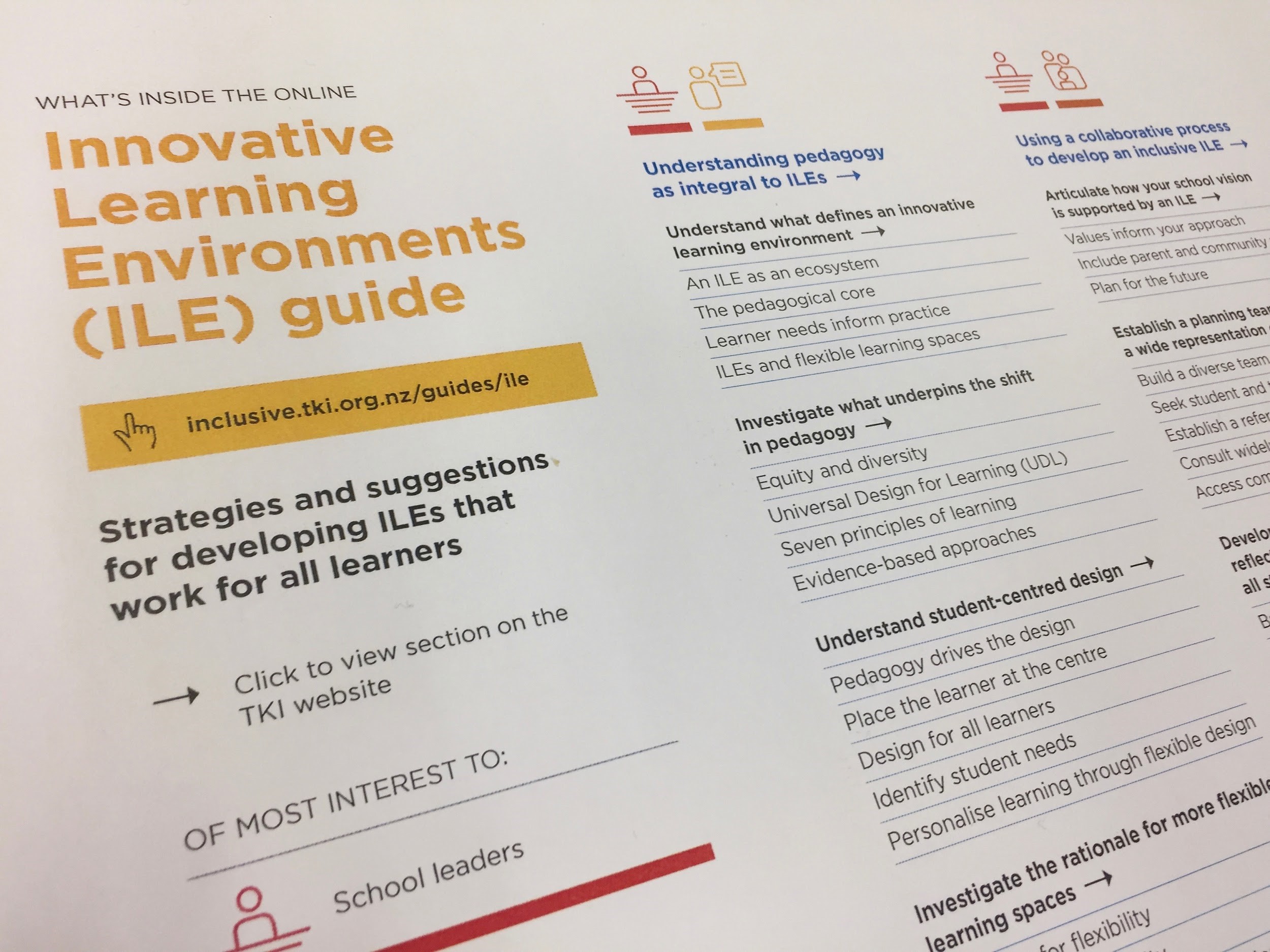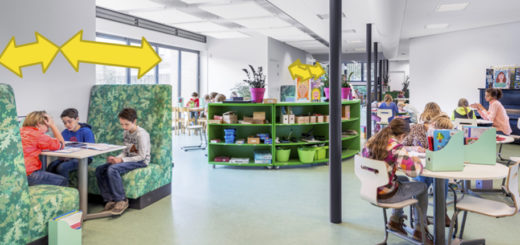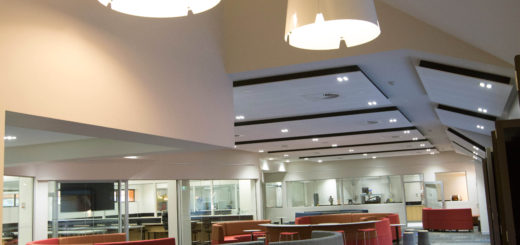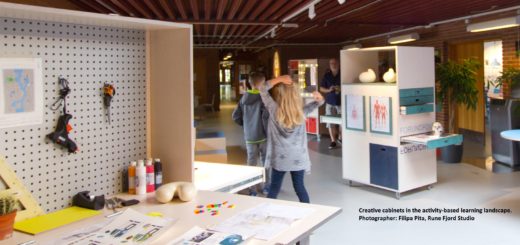Inclusion – ‘with’ not ‘for’

In this guest post Chrissie Butler, a consultant at CORE Education, discusses inclusive design and practices in ILEs and new resources recently released by the Ministry of Education in NZ….
If “education is a human right”, and diversity is a given, how can we design environments where everyone belongs and is learning to their full potential (UN General Assembly, 1948)?
In Aotearoa New Zealand we are building many new learning spaces. As inclusion is one of the eight principles underpinning The New Zealand Curriculum, schools are charged with ensuring that this principle informs and influences “all school decision making” including the design of new school buildings and building modifications (New Zealand Ministry of Education, 2007, p.9).
One expression of inclusion in an education context, is the valuing of “all students and all staff in all aspects of school life. It involves removing barriers to presence, participation, and achievement” so everyone can learn in a way that works for them (New Zealand Ministry of Education 2012, p1).
Creating new learning environments that are as inclusive as possible doesn’t happen by accident. It requires schools to engage in a planned collaborative journey of exploration and discovery, focused on inclusion with their community. An early milestone in that journey is the creation of opportunities for everyone involved to share their aspirations, their needs and insights for learners and learning. However, for communities to have confidence in the inclusive design of a learning space, and its ability to meet the needs of every child, they also need to be able to see that their contributions have had influence and have shaped final designs. This feedback loop, or circular storytelling, is a critical part of a school’s role. It is the signature of designing “with” a community rather than “for” a community.
To help school communities build some shared understandings and a shared vision for their inclusive flexible learning spaces, the Ministry of Education have illustrated six suggestions for consideration and discussion:
- New approaches to learning and the reasons for considering the flexible use of space
- Te Ao Māori and other cultural perspectives to ensure a respectful design that supports protocols and practices
- Gender and sexuality perspectives to support the design of a safe and socially inclusive environments
- Mobility needs and flexible options to support equitable access, navigation, and full participation
- Sensory needs and flexible options to minimise anxiety and support attention, concentration, and communication
- The impact of emotions and motivation, and options to support wellbeing and belonging.
As each suggestion is explored, schools are encouraged to seek the diverse perspectives of all members of their community in flexible and supported ways that work for them. This would also include connecting to local cultural leaders, learning specialists in areas such as dyslexia or deaf education and past students.
A unifying theme across these six suggestions is that schools need to be acutely sensitive to the individual differences that every student brings and must allow these differences to drive and influence design decisions (OECD 2013, New Zealand Ministry of Education 2016). Every student brings rich differences in cultures, languages, identities, relationships, experiences, abilities and interests to their community. These unique differences bring strength to a community and can be a source for innovation in the design process.
To illustrate this in action, here are two examples of designing “with” diversity in mind at the outset rather than designing “for” diverse others:
- Firstly let’s consider a ramp. In planning to meet the needs of one person, maybe someone using a wheelchair, consider how a ramp is also useful for pushchairs and makes it easier to make deliveries and move equipment. It’s what we call a universally designed solution, designed from the outset to be used in multiple ways by multiple users (Ministry of Education, 2017).
- Secondly, here is a cultural context for consideration. In Designing for Engagement, the video below, a teacher describes how understanding the cultural context of his community has influenced and informed the design of the learning space. The video is particularly pertinent as we consider the design of secondary education learning spaces.
Designing for engagement from New Zealand Ministry of Education on Vimeo.
To conclude, let’s take hold of this opportunity to create learning environments that reflect and meet the needs of the diverse communities they serve. To do that we need to keep inclusion as an explicit focus, work with the diversity our communities bring and expect that diversity to be a source of strength and innovation. Let’s also keep telling those circular stories, so that all involved can see that their contributions have had influence and have shaped those final designs.
For more examples of designing for inclusion, explore the Planning an innovative learning environment guide and it’s companion ILE guide summary (as shown in the header image).
Bibliography:
- New Zealand Ministry of Education. (2007). The New Zealand Curriculum. Wellington. Learning Media.
- New Zealand Ministry of Education. (2012). The New Zealand Curriculum Update: The Inclusion Principle. Retrieved August 2, 2017, from http://nzcurriculum.tki.org.nz/Curriculum-resources/NZC-Updates/Issue-18-March-2012
- New Zealand Ministry of Education. (2016). Planning an innovative learning environment | Inclusive Education. Retrieved August 2, 2017, from, http://inclusive.tki.org.nz/guides/ile/
- New Zealand Ministry of Education. (2017). UDL and the NZC. Retrieved August 2, 2017, from https://vimeo.com/220717678
- New Zealand Ministry of Education. (2015a). About inclusive education | Inclusive Education. Retrieved December 14, 2015, from http://inclusive.tki.org.nz/about-inclusiveeducation/
- OECD (2013), Innovative Learning Environments, OECD Publishing, Paris.
- http://dx.doi.org/10.1787/9789264203488-en
- UN General Assembly. (1948). Universal declaration of human rights (217 [III] A). Paris.
Chrissie Butler is a consultant at CORE Education working in the area of inclusive design and practices. She is also the lead writer and content developer for the Ministry of Education’s Inclusive Education website.



